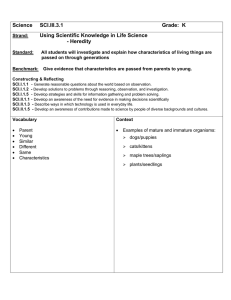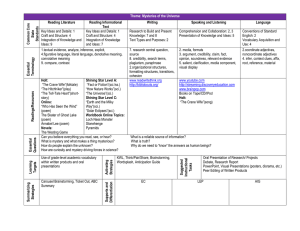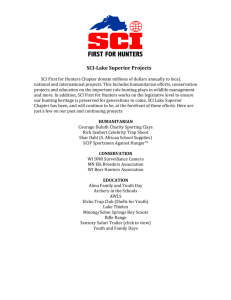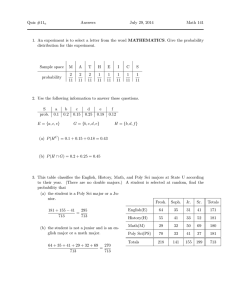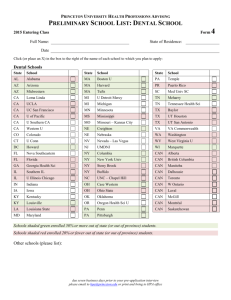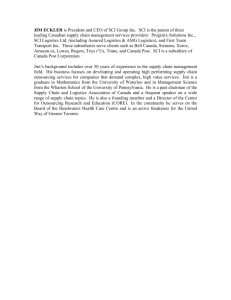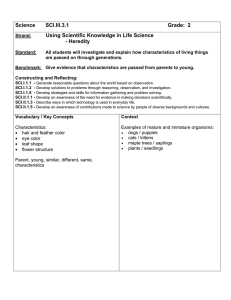Science SCI.III.3.1 Grade: 1
advertisement
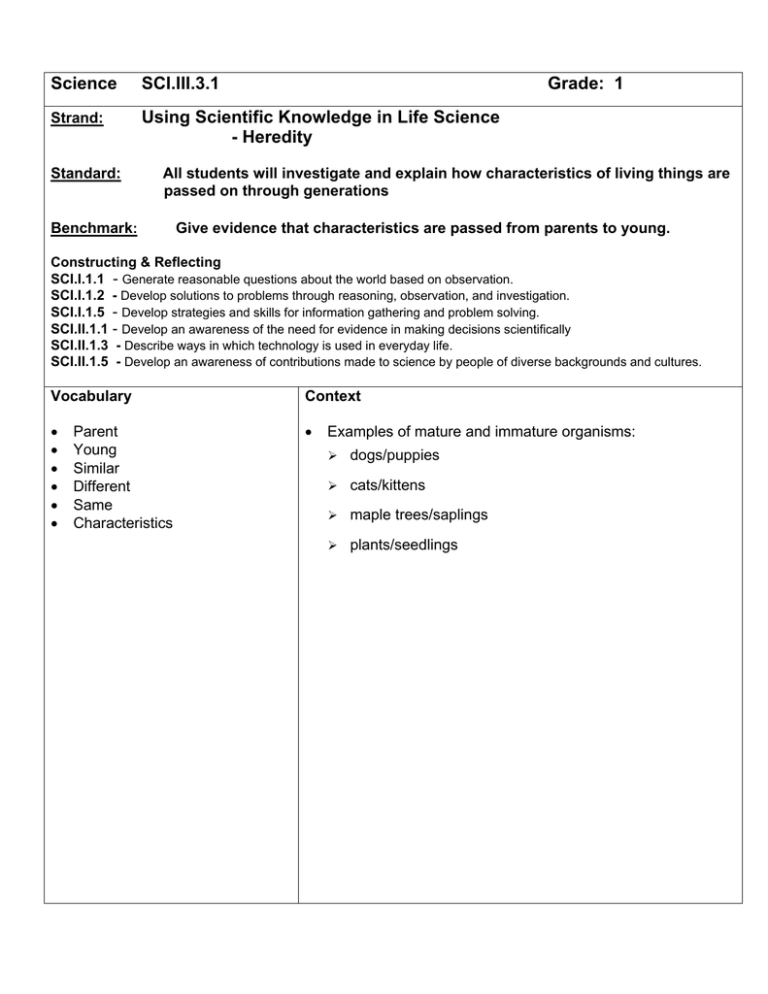
Science SCI.III.3.1 Strand: Using Scientific Knowledge in Life Science - Heredity Standard: Grade: 1 All students will investigate and explain how characteristics of living things are passed on through generations Benchmark: Give evidence that characteristics are passed from parents to young. Constructing & Reflecting SCI.I.1.1 - Generate reasonable questions about the world based on observation. SCI.I.1.2 - Develop solutions to problems through reasoning, observation, and investigation. SCI.I.1.5 - Develop strategies and skills for information gathering and problem solving. SCI.II.1.1 - Develop an awareness of the need for evidence in making decisions scientifically SCI.II.1.3 - Describe ways in which technology is used in everyday life. SCI.II.1.5 - Develop an awareness of contributions made to science by people of diverse backgrounds and cultures. Vocabulary Context • • • • • • • Parent Young Similar Different Same Characteristics Examples of mature and immature organisms: ¾ dogs/puppies ¾ cats/kittens ¾ maple trees/saplings ¾ plants/seedlings Knowledge and Skills Resources Benchmark Clarification: Coloma Resources: All living things pass on characteristics to their offspring. Common physical characteristics can be used to match the offspring of an organism with its parent. Students will: Newbridge Early Science Program “big books” and teaching guides: • Identify that a puppy looks like a dog • Identify that a kitten looks like a cat • Identify that saplings look like trees • Identify that seedlings look like plants Busy As a Bee (life cycle A Butterfly is Born (life cycle) An Apple a Day (life cycle Animals and Their Babies (heredity) Newbridge Discovery Links “little” readers with reproducible Home/School Connections black line masters.: Grow , Seed, Grow How Do Frogs Grow? Scott Foresman First Grade Reading Series, supportive stories: From Tadpole to Frog, Unit 1.2 The Same As You, Unit 1.4 Mothers and Babies cards from Science Poster Series. Animals and Their Babies matching cards. Other Resources: • Biography of Charles Darwin. • Webliography. http://mtn.merit.edu/mcf/SCI.III.3.E.1.html • Dinosaurs. http://www.nationalgeographic.com/dinorama/ • Guarino, Deborah, Is Your Mama a Llama? Scholastic,1997. • Nature magazines, animal books, computer flip-art. • Wild animal photos. http://www.nationalgeographic.com/kids/creature_feature/01 03/elephants2.html • Wildlife http://www.selu.com/bio/wildlife/ • Whose Baby Are You? Card game http://www.frankschaffer.com/ • Whose Baby Are You? 20 look and match photo puzzles http://www.livingandlearning.com/ Instruction Benchmark Question: What characteristics of living things are passed on through generations? Focus Question: What physical characteristics are shared between a young living thing and its parent? Students will each select an animal from the matching card set. Each child will then find its match (mature and immatjure). The teacher then will divide the class into small groups. Each member will put his or her two picture cards face down on a desk, mixed with the other members’ cards. In turn, students will flip one card over and attempt to find its mate. If no match is found after a child has turned up two cards, both cards are turned back over and play progresses to the next student. A student making a match must explain the shared characteristics to keep the matched cards. Play ends when all matches have been made. Assessment Optional Assessment: Teacher observation of children playing the game described under “Instruction.” Rubric for scoring student performance: Criteria Apprentice Basic Meets Exceeds Identificati on of common character istics Identifies up to one of the shared characteris tics. Identifies three of the shared character istics. Identifies four or more of the shared characteris tics -orIdentifies indistinct characteri stics that may make a positive link question able. Identifies two of the shared character istics. Teacher Notes: Investigate and explain how characteristics of living things are passed on through generations. Like produces like. To enable a child to understand why grandparents claim that they look just like their parents at their age requires many learning experiences. Elementary students should be able to provide evidence that visible traits are passed on from parents to children by comparisons of color, structure, and direct measurements. They should be able to match offspring to corresponding parents.


